2013 PEUGEOT 5008 light
[x] Cancel search: lightPage 4 of 364
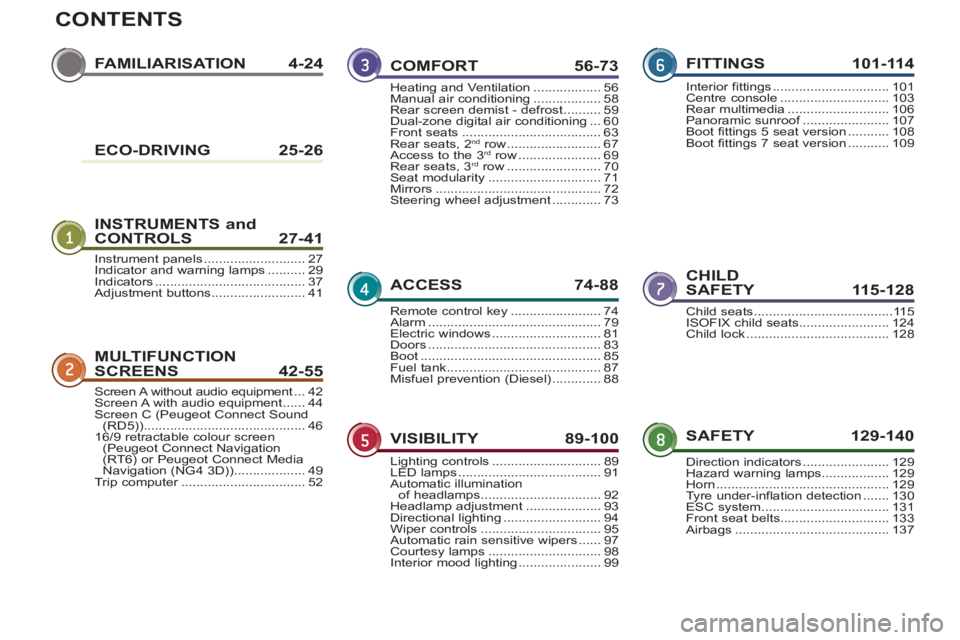
CONTENTS
FAMILIARISATION4-24
INSTRUMENTS and
CONTROLS 27-41
CHILD
SAFETY 115-128
MULTIFUNCTION
SCREEN
S42-55
SAFETY 129-140 COMFORT 56-7
3
ACCESS 74-88
VISIBILITY 89-100
FITTINGS 101-114
Instrument panels ...........................27Indicator and warning lamps ..........29Indicators........................................37Adjustment buttons.........................41
Child seats.....................................115ISOFIX child seats........................124Child lock......................................128
Screen A without audio equipment...t42Screen A with audio equipment......44Screen C (Peugeot Connect Sound (RD5))...........................................4616/9 retractable colour screen(Peugeot Connect Navigation (RT6) or Peugeot Connect Media
Navigation (NG4 3D))...................49Trip computer.................................r52
Direction indicators.......................129Hazard warning lamps..................129Horn..............................................129Tyre under-inflation detection .......130ESC system..................................131Front seat belts.............................133Airbags .........................................137
Heating and Ventilation ..................56Manual air conditioning ..................58Rear screen demist - defrost..........59Dual-zone digital air conditioning...60Front seats.....................................63Rear seats, 2nd row.........................67Access to the 3rdrow ......................69Rear seats, 3rdrow.........................70Seat modularity..............................71Mirrors............................................72Steering wheel adjustment .............73
Remote control key........................74Alarm..............................................79Electric windows.............................81Doors ..............................................83Boot................................................85Fuel tank.........................................87Misfuel prevention (Diesel).............88
Lighting controls.............................89LED lamps......................................91Automatic illumination
of headlamps................................92Headlamp adjustment ....................93Directional lighting..........................94Wiper controls................................95Automatic rain sensitive wipers ......97Courtesy lamps..............................98Interior mood lighting......................99
Interior fittings ...............................101Centre console .............................103Rear multimedia...........................106Panoramic sunroof.......................f107Boot fittings 5 seat version ...........108Boot fittings 7 seat version ...........109ECO-DRIVING 25-26
Page 6 of 364

FA
M
4
EXTERIOR
Welcome lighting
This additional exterior and interior lighting,
controlled remotely, makes your approach
to the vehicle easier when the light is poor.
91
Stop & Start
This system puts the engine temporarily
into standby during stops in the traffi c (red
lights, traffi c jams, etc...). The engine re-
starts automatically as soon as you want
to move off. The Stop & Start system
reduces fuel consumption and exhaust
emissions and provides the comfort of
complete silence when stationary
165
Directional lighting
This lighting automatically provides addi-
tional visibility when cornering.
94
Panoramic sunroof
This roof provides incomparable visibility
and light in the passenger compartment.
107
Page 8 of 364
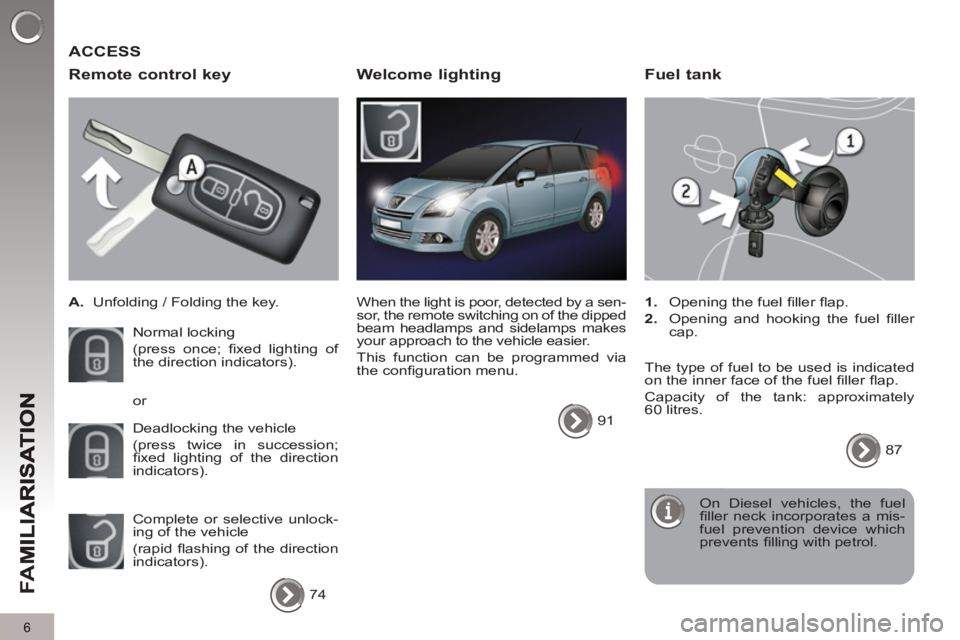
FA
M
6
ACCESS
Remote control ke
y
A.
Unfolding / Folding the key.
Normal locking
(press once; fi xed lighting of
the direction indicators).
Deadlocking the vehicle
(press twice in succession;
fi xed lighting of the direction
indicators).
Complete or selective unlock-
ing of the vehicle
(rapid fl ashing of the direction
indicators). or
74 When the light is poor, detected by a sen-
sor, the remote switching on of the dipped
beam headlamps and sidelamps makes
your approach to the vehicle easier.
This function can be programmed via
the confi guration menu.
91
87
Fuel tank
1.
Opening the fuel fi ller fl ap.
2.
Opening and hooking the fuel fi ller
cap.
The type of fuel to be used is indicated
on the inner face of the fuel fi ller fl ap.
Capacity of the tank: approximately
60 litres.
Welcome lighting
On Diesel vehicles, the fuel
fi ller neck incorporates a mis-
fuel prevention device which
prevents fi lling with petrol.
Page 11 of 364

FA
M
9
INSTRUMENTS AND CONTROLS
1.
Cruise control / speed limiter
switches.
2.
Steering wheel adjustment.
3.
Lighting and direction indicator
stalk.
4.
Instrument panel.
5.
Driver's airbag.
Horn.
6.
Gear lever.
7.
Electric parking brake.
8.
12 V accessories socket.
9.
Panoramic sunroof control.
10.
Owner's Handbook storage
compartment.
11 .
Bonnet release.
12.
Door mirror controls.
Electric window controls.
Child lock.
13.
Manual headlamp height adjustment.
14.
Alarm button.
Parking sensors button.
Dynamic stability control (ESC/
ASR) button.
Stop & Start.
15.
Front door window demist/defrost
vent.
16.
Windscreen demist/defrost vent.
Page 16 of 364
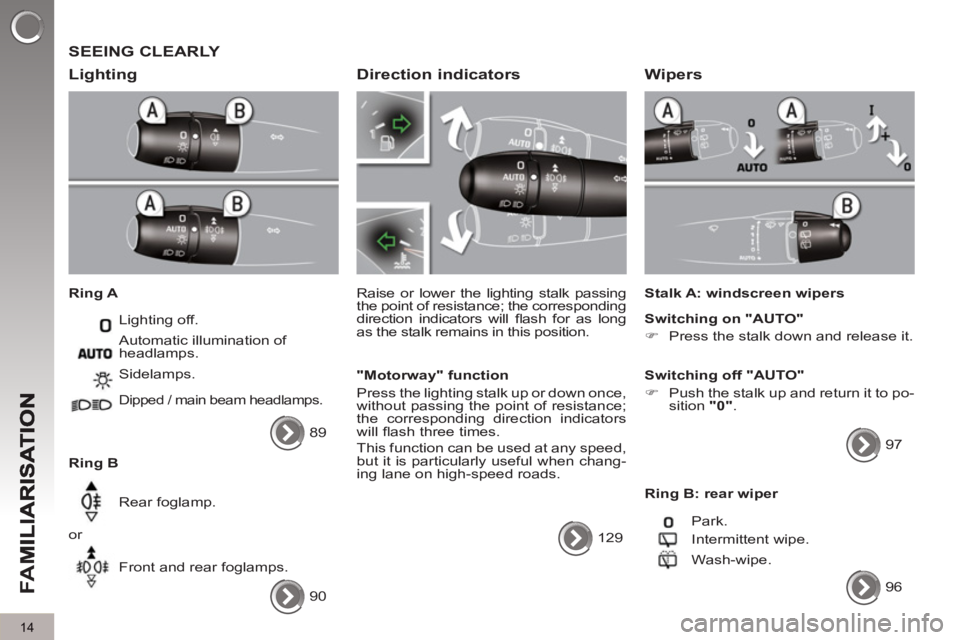
FA
M
14
SEEING CLEARLY
Li
ghting
Ring A
Lighting off.
Ring B Sidelamps.
Dipped / main beam headlamps.
Rear foglamp.
or
Front and rear foglamps. Automatic illumination of
headlamps.
90
Direction indicators
Raise or lower the lighting stalk passing
the point of resistance; the corresponding
direction indicators will fl ash for as long
as the stalk remains in this position.
"Motorway" function
Press the lighting stalk up or down once,
without passing the point of resistance;
the corresponding direction indicators
will fl ash three times.
This function can be used at any speed,
but it is particularly useful when chang-
ing lane on high-speed roads.
129
Wipers
Stalk A: windscreen wipers
Switching on "AUTO"
�)
Press the stalk down and release it.
Switching off "AUTO"
�)
Push the stalk up and return it to po-
sition "0"
.
97
Ring B: rear wiper
Park.
Intermittent wipe.
Wash-wipe.
96
89
Page 18 of 364
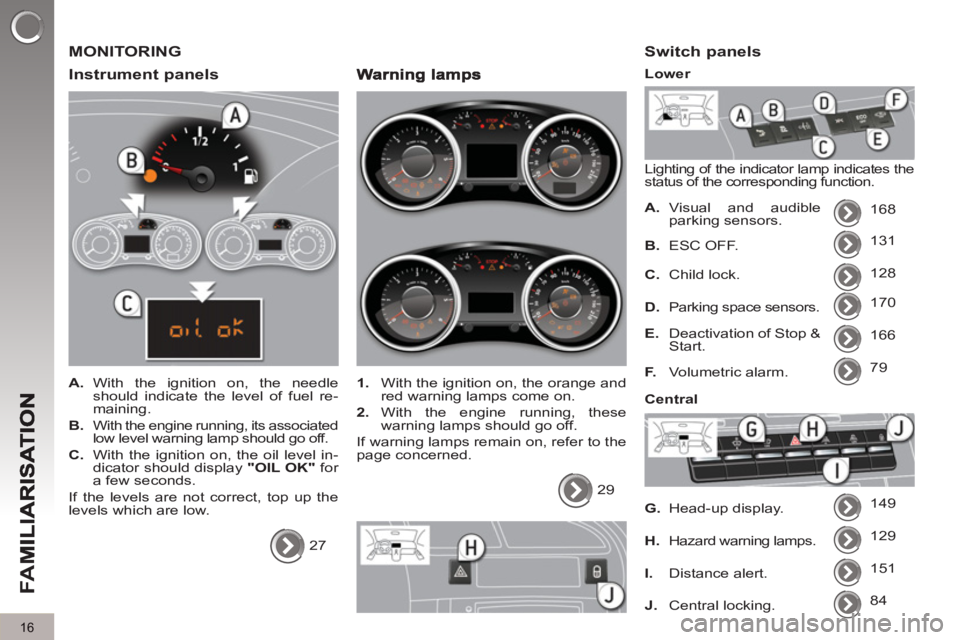
FA
M
16
MONITORING
Instrument
panels
A.
With the ignition on, the needle
should indicate the level of fuel re-
maining.
B.
With the engine running, its associated
low level warning lamp should go off.
C.
With the ignition on, the oil level in-
dicator should display "OIL OK"
for
a few seconds.
If the levels are not correct, top up the
levels which are low.
27
1.
With the ignition on, the orange and
red warning lamps come on.
2.
With the engine running, these
warning lamps should go off.
If warning lamps remain on, refer to the
page concerned.
29
Switch panels
Lighting of the indicator lamp indicates the
status of the corresponding function.
A.
Visual and audible
parking sensors. 168
131
128
170
166
79
149
129
B.
ESC OFF.
C.
Child lock.
D.
Parking space sensors.
E.
Deactivation of Stop &
Start.
F.
Volumetric alarm.
G.
Head-up display.
H.
Hazard warning lamps.
Lower
Central
151
I.
Distance alert.
84
J.
Central locking.
Page 19 of 364
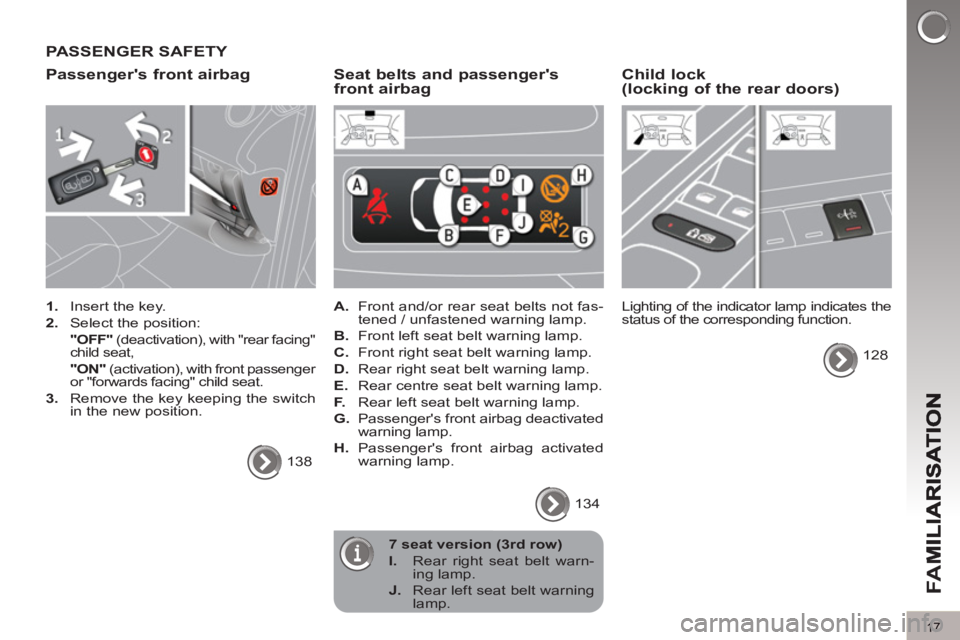
FA
M
17
PASSENGER SAFETY
Passen
ger's front airbag
1.
Insert the key.
2.
Select the position:
"OFF"
(deactivation), with "rear facing"
child seat,
"ON"
(activation), with front passenger
or "forwards facing" child seat.
3.
Remove the key keeping the switch
in the new position.
138
Seat belts and passenger's front airbag
A.
Front and/or rear seat belts not fas-
tened / unfastened warning lamp.
B.
Front left seat belt warning lamp.
C.
Front right seat belt warning lamp.
D.
Rear right seat belt warning lamp.
E.
Rear centre seat belt warning lamp.
F.
Rear left seat belt warning lamp.
G.
Passenger's front airbag deactivated
warning lamp.
H.
Passenger's front airbag activated
warning lamp.
134
Child lock (locking of the rear doors)
Lighting of the indicator lamp indicates the
status of the corresponding function.
128
7 seat version (3rd row)
I.
Rear right seat belt warn-
ing lamp.
J.
Rear left seat belt warning
lamp.
Page 27 of 364
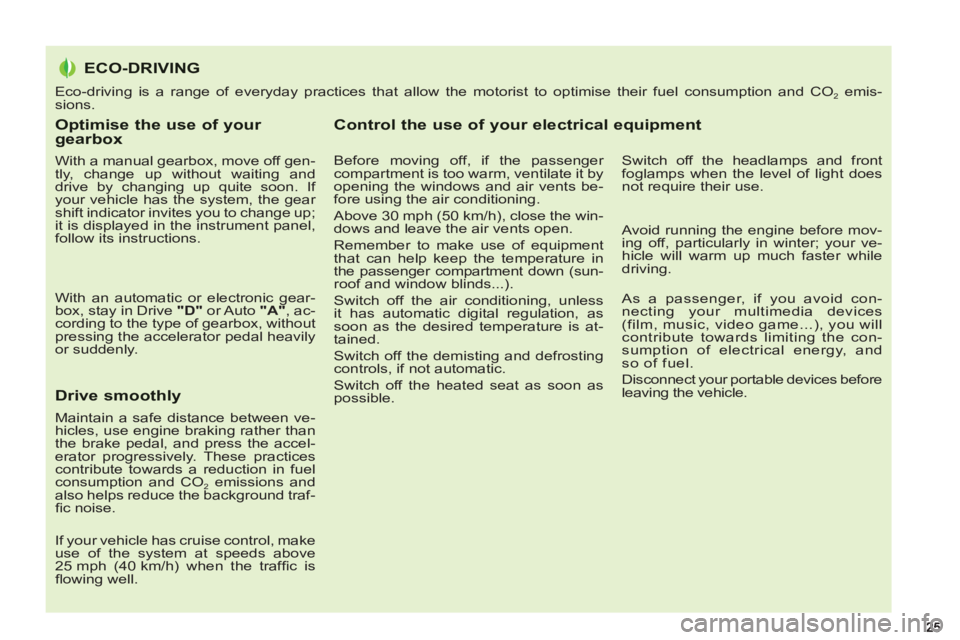
Optimise the use of your gearbox
With a manual gearbox, move off gen-
tly, change up without waiting and
drive by changing up quite soon. If
your vehicle has the system, the gear
shift indicator invites you to change up;
it is displayed in the instrument panel,
follow its instructions.
With an automatic or electronic gear-
box, stay in Drive "D"
or Auto "A"
, ac-
cording to the type of gearbox, without
pressing the accelerator pedal heavily
or suddenly.
Drive smoothly
Maintain a safe distance between ve-
hicles, use engine braking rather than
the brake pedal, and press the accel-
erator progressively. These practices
contribute towards a reduction in fuel
consumption and CO
2 emissions and
also helps reduce the background traf-
fi c noise.
If your vehicle has cruise control, make
use of the system at speeds above
25 mph (40 km/h) when the traffi c is
fl owing well.
Control the use of your electrical equipment
Before moving off, if the passenger
compartment is too warm, ventilate it by
opening the windows and air vents be-
fore using the air conditioning.
Above 30 mph (50 km/h), close the win-
dows and leave the air vents open.
Remember to make use of equipment
that can help keep the temperature in
the passenger compartment down (sun-roof and window blinds...).
Switch off the air conditioning, unless
it has automatic digital regulation, as
soon as the desired temperature is at-
tained.
Switch off the demisting and defrosting
controls, if not automatic.
Switch off the heated seat as soon as
possible.
Switch off the headlamps and front
foglamps when the level of light does
not require their use.
Avoid running the engine before mov-
ing off, particularly in winter; your ve-
hicle will warm up much faster while
driving.
As a passenger, if you avoid con-
necting your multimedia devices
(film, music, video game...), you will
contribute towards limiting the con-
sumption of electrical energy, and
so of fuel.
Disconnect your portable devices before
leaving the vehicle.
ECO-DRIVING
2525
Eco-driving is a range of everyday practices that allow the motorist to optimise their fuel consumption and CO2 emis-
sions.